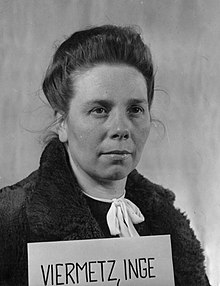Inge Viermetz

Inge Viermetz (born March 7, 1908 in Aschaffenburg ; † April 23, 1997 in Vaterstetten ) was a German department head at Lebensborn eV at the time of National Socialism .
Life
Viermetz attended elementary school in Aschaffenburg from 1914 to 1918 and then switched to the lyceum , which she left before completing her Abitur . She then graduated from business school, which she successfully completed in 1923. From 1923 to 1932 Viermetz worked as a stenographer for various companies in Krefeld . She married in 1932 and moved to Austria. Viermetz returned to Germany in 1935 and worked first as a correspondent at a textile factory in Augsburg until 1938 and then as a secretary at a racecourse in Munich . Their marriage ended in divorce in 1936. She remarried in 1939.
Viermetz became a member of the National Socialist People's Welfare (NSV), the National Socialist Women's Association and the Reich Colonial Association in 1937 .
Activity at Lebensborn eV
After a short period of unemployment, Viermetz was employed by the employment office at the Lebensborn association in Munich and from that point on belonged to the female SS entourage . Viermetz initially worked as a typist in the home admission department. From September 1939 she took over the job placement department, through which single mothers were placed in employment. In personal union, she was also responsible for the department of nursing homes and adoption placement . In January 1941 she was again a clerk in the home admission department , headed the war orphans department from March 1941 to May 1941 and then the home admission department until September 1941 . By order of the managing director of the Lebensborn eV Max Sollmann , Viermetz headed the main labor department (A) with Ernst Ragaller from September 1941 to December 1941 . Then she was deputy head of Department A until the beginning of May 1942 under the acting head of Sollmann.
As part of a Germanization campaign, she was responsible for bringing 300 Polish children from the Wartheland to the German Reich . The children were housed in homes in Lebensborn.
After Gregor Ebner had received her post as Head of Department A in May 1942, she asked to be released from her employment. As a reason she cited the absence of her husband, who served as a soldier in World War II , and his absence from his business. However, Sollmann did not comply with this. Instead, Sollmann appointed her as a special representative. In this function she carried out further Germanization campaigns for children by means of business trips to Yugoslavia and Wartheland, among other places . From December 1942 to summer 1943 she was the Lebensborn representative for Belgium and northern France and headed the Ardennes children's home in Végimont . Due to financial irregularities, Viermetz was released from her activities at Lebensborn eV in the summer of 1943 and dismissed there on December 21, 1943 without notice.
Viermetz then lived in Munich and was evacuated to Winhöring in February 1944 due to the war .
After the end of the war
After the war ended, Viermetz was arrested and interned at the end of July 1945. In January 1946 she was released from prison and initially lived in Winhöring again and from December 1946 in Munich. In January 1947, Viermetz was arrested and imprisoned again. Viermetz was indicted on July 1, 1947, along with 13 other accused , as part of the Nuremberg Trials in the Race and Settlement Main Office trial of the SS . Viermetz was accused of abducting children from abroad and of forcing them into German. She justified herself on the grounds that she was just a subordinate employee who acted out of pity. In addition, it represented the Lebensborn as a welfare institution. On March 10, 1948, Viermetz was acquitted.
Four Metz in 1950 from Munich's main Spruchkammer together with target man, Ebner and other accused denazified . Nothing is known about her further life.
literature
- Andrea Böltken: Leaders in the Führer state: Gertrud Scholtz-Klink, Trude Mohr, Jutta Rüdiger and Inge Viermetz . Centaurus-Verlag, Pfaffenweiler 1995, Forum Frauengeschichte Vol. 18, ISBN 3-89085-926-7 .
- Kathrin Kompisch: perpetrators. Women in National Socialism , Böhlau Verlag, Cologne 2008, ISBN 978-3-412-20188-3 .
- Volker Koop: Giving the Führer a child - the SS organization “Lebensborn” eV Böhlau Verlag, Cologne 2007; 306 pages. ISBN 978-3-412-21606-1 .
Web links
- The Lebensborn eV (PDF file; 51 kB)
- Dr. Tesch's rumor folder - Himmler's sex appeal , in: Der Spiegel , issue 14/1948 of April 10, 1948
Individual evidence
- ↑ Precise life data according to JDG database
- ↑ Volker Koop: Giving the Führer a child - the SS organization “Lebensborn” eV , Cologne 2007, p. 227ff.
| personal data | |
|---|---|
| SURNAME | Viermetz, Inge |
| BRIEF DESCRIPTION | German head of department at Lebensborn eV |
| DATE OF BIRTH | March 7, 1908 |
| PLACE OF BIRTH | Aschaffenburg |
| DATE OF DEATH | April 23, 1997 |
| Place of death | Vaterstetten |
